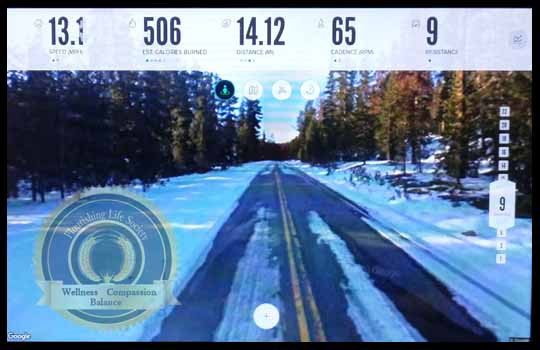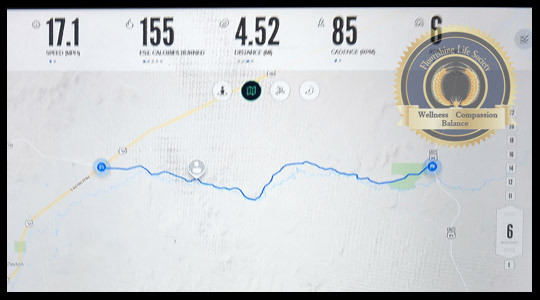Like many, the pandemic disrupted my normal routines and led to some unwanted weight gain. Life adjustments and new habits slowly added extra pounds. It happens subtly, then one day you look in the mirror and realize a change is needed. After struggling with traditional weight loss methods, I found a solution that worked for me: riding an exercise bike. This is my story of how incorporating an exercise bike into my daily routine became a fun and effective path to weight loss and improved fitness.
The Knee-Pain Running Dilemma (and the Exercise Bike Solution)
Running was always my go-to for fitness. I enjoyed it in high school and returned to it throughout adulthood to boost stamina, endurance, and shed a few pounds. So, naturally, I thought running would be the answer to my recent weight gain. I invested in new running shoes, downloaded a fitness app, and explored local trails. Despite being in my fifties, I embraced trail running again, enjoying the fresh air and the challenge of hill workouts.
However, my knees had other plans. Each time I increased my weekly mileage enough to see weight loss results, knee pain and inflammation would flare up. I tried different shoes, knee braces, and softer running surfaces, but nothing resolved the issue. Running, my trusted fitness friend, was no longer a sustainable solution. This is a common issue, and for many, like myself, an exercise bike offers a fantastic low-impact alternative. Exercise bikes provide a cardiovascular workout without the jarring impact on joints, making them ideal for individuals with knee problems or those seeking a gentler form of exercise.
Discovering Interactive Exercise Bikes: Beyond the Peloton Price Tag
I was determined to get fit and healthy, especially with grandchildren to keep up with! But I knew that wanting to be healthy and actually being healthy are two different things. My knee pain became a convenient excuse to abandon regular exercise. As Art Markman, Ph.D., notes, “knowledge alone does not cause people to change their behavior. And even a commitment to change is not enough” (Markman, 2015). I needed something more engaging to stick with it.
Then, I saw a commercial for a Peloton bike. The interactive classes intrigued me. A quick online search revealed the high price tag, quickly dismissing that particular option. However, the concept of interactive spin classes and cycling trainers remained appealing. The idea of bringing the energy of a studio spin class into my home, combined with the convenience of an exercise bike, was compelling.
My research led me to Pro-Form’s version of the interactive exercise bike. The Pro-TC offered similar features to Peloton, using an iFit subscription for access to spin classes and trainer-led rides around the world. An attractive offer – a free bike with a three-year iFit subscription agreement – sealed the deal. Exploring different brands and models, I discovered that there are exercise bikes available for various budgets and needs, many offering interactive features to enhance motivation and workout enjoyment.
My First Weeks with an Exercise Bike
Assembly was straightforward, and soon my exercise bike was ready. Eager to start, I chose a beginner ride around a scenic Norwegian lake. Two miles in, my legs were fatigued, and my heart was racing. Slightly discouraged, I ended the workout. It was a reminder that even though exercise bikes are low-impact, they still provide a significant workout!
However, my body adapted quickly. Within a few weeks, my muscles and cardiovascular system adjusted. I explored trainer-led sessions on virtual trails worldwide and even tried a few online spin classes. The variety of workouts available through iFit and similar platforms kept things interesting and challenging. For anyone new to exercise bikes, starting slowly and gradually increasing workout intensity is key to building endurance and avoiding discouragement.
I then discovered the “create” feature on my exercise bike. Remarkably, I could link it to Google Maps, plot a route, and the bike would generate a custom workout. I virtually cycled through my childhood town of Tucson, explored the streets of Paris, and visited Charleston. This feature turned my exercise bike workouts into virtual adventures!
The Google Maps integration wasn’t flawless. Instead of video, the screen displayed scrolling Google Street View photos. Some areas lacked photo coverage entirely. However, the bike intelligently adjusted resistance to simulate hills, and the photo gaps were minor. The immersive experience, despite its imperfections, was highly motivating. As Isabelle M. Baur and Roy F, Baumeister explain, “successful self-regulation allows people to subordinate short-term temptations to long-term goals, to trade the pleasure of immediate gratification for delayed rewards, and to tolerate the frustration that can be associated with persisting in the face of challenges or hard work” (Bauer & Baumeister, 2017. Kindle location: 2,097). The interactive and engaging nature of the exercise bike helped me overcome the initial challenges and stay committed.
Setting Goals and Seeing Results
Despite enjoying the virtual rides, something felt missing. I needed a bigger, more encompassing goal to tie my workouts together, something beyond just individual bike rides. Then it struck me: “I’m going to ride this bike across the country,” I announced to my wife. Ever supportive of my ambitious ideas, she simply replied, “You do that, Troy.”
I was ready to commit and knew I needed to start immediately. DiClemente states that the preparation stage “entails developing a plan of action and creating the commitment needed to implement that plan” (DiClemente, 2005). Gregg Krech further warns, “most procrastination is caused by a tendency to make a decision, in the present moment, based on what we feel like doing at that moment. And if we don’t feel like doing something NOW, then we’re not likely to feel like doing it later, because…later will just be another NOW” (Krech, 2014).
Riding the wave of motivation, I hopped on my exercise bike and began my virtual cross-country trek, starting from my living room in sunny California. Early progress was slow, just a few miles at a time. But within a couple of weeks, I was consistently riding twenty miles or more daily. Soon, I was virtually crossing the Sierras and descending into Nevada.
 ProForm Stationary Bike. Riding my Pro-Form Stationary Bike Across the Country. A Flourishing Life Society article body image 1
ProForm Stationary Bike. Riding my Pro-Form Stationary Bike Across the Country. A Flourishing Life Society article body image 1
Smaller Goals
The grand goal of reaching Boston was broken down into smaller, more manageable objectives. Daily goals like “make it to Reno today” and weekly goals like “reach the Utah border by week’s end” provided consistent motivation. We need goals to stay inspired, but overly daunting goals can lead to discouragement. Breaking down a large goal into smaller, achievable steps is crucial for sustained motivation, especially when using an exercise bike for weight loss or fitness.
These smaller goals kept me engaged and pushing myself. I incorporated sprint intervals into flat virtual rides and utilized the simulated terrain for hill workouts. Two months into my virtual journey, I felt like Forrest Gump, charging towards Nebraska on my exercise bike.
 ProForm Stationary Bike. Riding my Pro-Form Stationary Bike Across the Country. A Flourishing Life Society article body image 2
ProForm Stationary Bike. Riding my Pro-Form Stationary Bike Across the Country. A Flourishing Life Society article body image 2
Real Fitness Gains: Weight Loss and Health Improvements with Exercise Bikes
This virtual cross-country ride wouldn’t have been worthwhile if I hadn’t achieved my primary fitness goal: weight loss. Here’s what happened to my body in the first six weeks of regularly using my exercise bike:
- I lost twenty pounds.
- My resting heart rate decreased from the low seventies to the mid-fifties.
- My blood pressure dropped from a concerning 135/95 to a healthy 115/75.
These results highlight the effectiveness of exercise bikes for weight loss and overall health improvement. Consistent exercise bike workouts can significantly contribute to calorie burning, cardiovascular health, and achieving a healthier body composition.
Maintaining Momentum and Continuing the Journey
Eventually, I virtually reached Boston. Like any long-term goal, there were obstacles along the way. A move to a new home in the Midwest meant storing my exercise bike for a few months. At the new house, a back injury from yard work temporarily halted my journey. Other unexpected life events also caused delays.
However, the goal of reaching Boston remained in my mind. I knew I had to finish. Once recovered and settled, I got back on my exercise bike and completed the virtual cross-country trip. To celebrate, my wife and I even took a trip to Boston! The journey continues; I’m now virtually heading south from Boston to the Florida Keys on my trusty exercise bike. This experience taught me the importance of perseverance and how an exercise bike can be a consistent tool for long-term fitness goals.
Why an Exercise Bike Might Be Your Ideal Fitness Partner
A grand, virtual cross-country ride might not be for everyone. My wife, for example, prefers her favorite iFit trainers and is achieving her fitness goals in her own way. However, for me, the exercise bike has been transformative.
My knees are happy with the low-impact cycling, I’ve achieved my weight loss goals, and I remain motivated as I virtually cycle across the flat plains of middle America. Exercise bikes offer a convenient, effective, and engaging way to achieve fitness goals, regardless of your preferred workout style or virtual destination. Whether you’re looking to lose weight, improve cardiovascular health, or find a joint-friendly exercise option, an exercise bike is worth considering.
Last Update: August 15, 2024
Psychological of Wellness
Self-Improvement
Health and Fitness
Motivation Theories
Discover More from Psychology Fanatic
Subscribe to get a weekly update of newly published articles to your email
Join 51.9K other subscribers
References:
Baumeister, Roy F.; Bauer, Isabelle M. (2017). Self-Regulatory Strength. K. D. Vohs, & R. F. Baumeister (Eds.), Handbook of Self-Regulation: Third Edition: Research, Theory, and Applications. The Guilford Press; Third edition.
DiClemente, Carlos C. (2005) Addiction and Change, Second Edition: How Addictions Develop and Addicted People Recover. The Guilford Press; Second edition.
Krech, Gregg (2014). The Art of Taking Action: Lessons from Japanese Psychology. ToDo Institute Books.
Markman, Art (2015). Smart Change: Five Tools to Create New and Sustainable Habits in Yourself and Others. TarcherPerigee; Reprint edition.
Resources and Articles
Please visit Psychology Fanatic’s vast selection of articles, definitions and database of referenced books.
*Many of the quotes from books come books I have read cover to cover. I created an extensive library of notes from these books. I make reference to these books when using them to support or add to an article topic. Most of these books I read on a kindle reader. The Kindle location references seen through Psychology Fanatic is how kindle notes saves my highlights.
Please note that some of the links in this article are affiliate links. If you purchase a product through one of these links, I may receive a small commission at no additional cost to you. This helps support the creation of high-quality content and allows me to continue providing valuable information.
The peer reviewed article references mostly come from Deepdyve. This is the periodical database that I have subscribe to for nearly a decade. Over the last couple of years, I have added a DOI reference to cited articles for the reader’s convenience and reference.
Thank-you for visiting Psychology Fanatic. Psychology Fanatic represents nearly two decades of work, research, and passion.
Topic Specific Databases:
PSYCHOLOGY – EMOTIONS – RELATIONSHIPS – WELLNESS – PSYCHOLOGY TOPICS
Share this:
Discover more from Psychology Fanatic
Subscribe to get the latest posts sent to your email.

